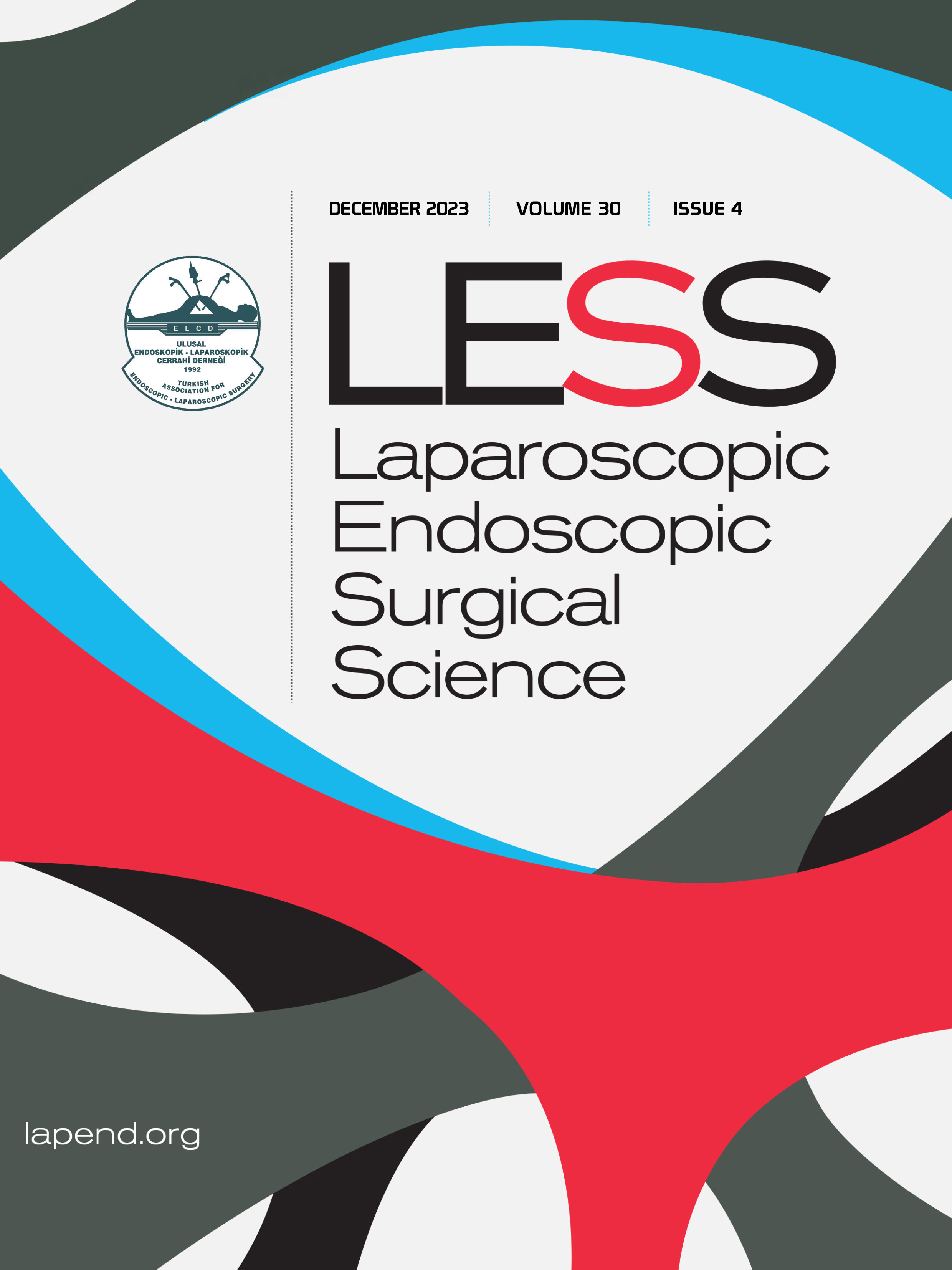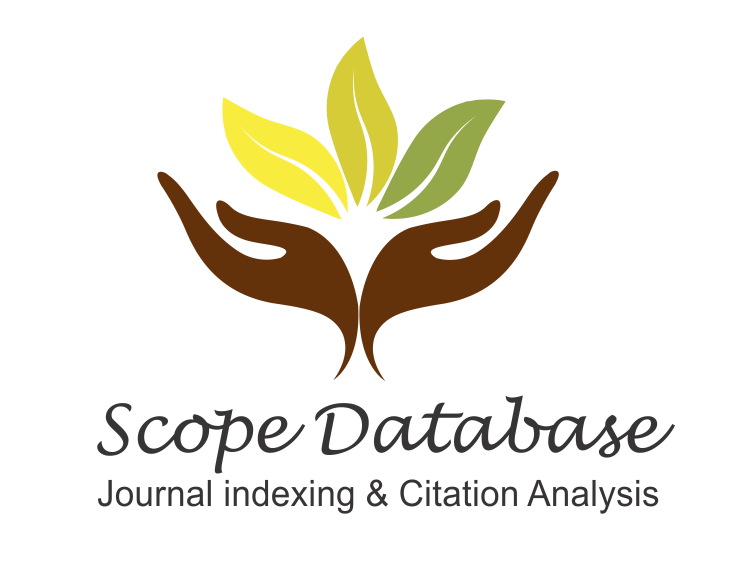Volume: 29 Issue: 3 - 2022
| 1. | Front Matter 2022-3 Pages I - IV |
| RESEARCH ARTICLE | |
| 2. | Transnasal endoscopic approach in repair of choanal atresia Cevat Uçar doi: 10.14744/less.2022.38233 Pages 123 - 127 INTRODUCTION: The aim of the surgical treatment in choanal atresia is to open the posterior nasal aperture priformis. For this purpose, many methods have been applied to date, and the transnasal endoscopic approach has been the preferred method in recent years and used in our study. METHODS: Between 1996 and 2017, transnasal endoscopic surgery was performed in six patients with the diagnosis of unilateral choanal atresia, atresia plaque resection and stent placement were performed in two patients, and stentless atresia plaque and posterior vomer resection operations were performed in four patients. Our patients were followed for at least 2 years and their results were evaluated. RESULTS: Choanal atresia was unilateral in all of our patients. Four of six patients were male and two were female. Our youngest patient was 7 years old, and our oldest patient was 22 years old, with a mean age of 13.6 years. Of the atresia plaques, four were osseomembranous and two were membranous. Adequate choanal patency was achieved in our patients who underwent atretic plaque and posterior vomer resection and did not use a stent. Restenosis developed in patients who underwent atretic plaque resection and used stent. In these patients, stent-free, posterior vomer resection was performed in revision surgery. DISCUSSION AND CONCLUSION: We believe that in the treatment of choanal atresia, atretic plaque and posterior vomer resection with the help of transnasal endoscopic surgery gives successful results, and the choanal opening opened without stenting provides adequate nasal breathing. |
| 3. | Changes in laboratory findings and early postoperative radiological evaluations following laparoscopic sleeve gastrectomy Hüseyin Akyol, Berrin Erok, Abdulrahman Idrees doi: 10.14744/less.2022.86658 Pages 128 - 133 INTRODUCTION: Obesity is an important public health problem with its related comorbidities associated with chronic inflammation. Secretion and continued release of inflammatory mediators such as tumor necrosis factor-alpha and interleukin-6 are caused by hypertrophic growth of adipose tissue and lead to chronic inflammation. In this study, we aimed to retrospectively evaluate the changes in the hematological and biochemical profiles and also to review complications established in post-operative radiological imaging studies following laparoscopic sleeve gastrectomy (LSG). METHODS: The changes in the obesity-related biochemical and hematological parameters 6 months after LSG were retrospectively analyzed in 143 consecutive patients older than 18-year of age who underwent LSG. In addition, the findings of abdominal ultrasonography (US) examinations in all patients and computed tomography findings in patients who had been performed were retrospectively reviewed in terms of post-operative complications. RESULTS: The decrease in body mass index (BMI) compared to the pre-operative BMI was statistically significant. Both inflammatory markers and glucose-lipid profiles showed improvement with a positive correlation parallel to the change in BMI. Neutrophil-lymphocyte ratio was found to be decreased significantly. However, no significant change was observed in PLR 6 months after LSG. Newly developed gallstones appeared in six of the patients when compared with their pre-operative abdominal US reports. None of the patients had gastric leak, perigastric collection, or hemorrhage. DISCUSSION AND CONCLUSION: LSG is one of the most effective bariatric surgery methods in the treatment of obesity. We showed improvements in inflammatory markers in addition to glucose and lipid profiles with a positive correlation parallel to the changes in BMI. |
| 4. | The effect of helicobacter pylori infection on thyroid function tests in diabetic patients and its relationship with autoimmune thyroiditis Sena Yazıcı Alcan, Arzu Cennet Işık, Gizem Geçmez, Banu Boyuk, Özcan Keskin doi: 10.14744/less.2022.83798 Pages 134 - 141 INTRODUCTION: In this study, we aimed to show the effect of Helicobacter pylori presence on thyroid function tests and its relationship with autoimmune thyroiditis in patients with Type 2 diabetes mellitus (DM) with dyspeptic complaints. METHODS: Our randomized and retrospective study was planned with 136 Type 2 patients with DM who were followed up from our gastroenterology outpatient clinic and diabetes unit between January 2019 and January 2020. Biopsy samples of patients undergoing gastroscopy due to dyspepsia are evaluated pathologically. The relationship between the presence of H. pylori and autoimmune thyroiditis is investigated by looking at demographic and laboratory findings and thyroid function tests. RESULTS: 136 diabetic patients between the ages of 3185, with a mean age of 60.03±9.82 years, 43 of whom male (31.6%) and 93 female (68.4%), were considered. H. pylori positivity was detected in 41.9% (n=57) of the cases. In H. pylori positive cases, the body mass index (BMI) value was found to be significantly higher (p<0.01). There was no significant relationship between H. pylori positivity and thyroid function test level or gender (p>0.05). In addition, gastroesophageal reflux and atrophy were higher in patients with H. pylori (p=0.001; p<0.01). The ODDS ratio of the presence of atrophy in anti-TPO positive cases was 5,409 (95% CI: 1,96214,900) and no relationship was found between Anti-TPO positivity and H. pylori positivity (p>0.05). DISCUSSION AND CONCLUSION: Although H. pylori positivity is common in Type 2 DM patients, no relationship was found between thyroid function test level and anti-TPO positivity (autoimmune thyroiditis). Meanwhile, the BMI value, acid reflux, and gastric atrophy were found to be more common in case of H. pylori positivity and autoimmune thyroiditis to be associated with atrophic gastritis. It can thus be recommended for obese, diabetic patients with dyspeptic mellitus disease to be evaluated in terms of thyroid function. |
| 5. | Analysis of upper gastrointestinal endoscopy results during the COVID-19 pandemic and the impact of SARS-CoV-2 on gastric histopathology: A single-center experience Aziz Serkan Senger, Mehmet Emirhan Işık doi: 10.14744/less.2022.17999 Pages 142 - 147 INTRODUCTION: This study was undertaken to compare and analyze changes in the gastroscopy biopsies in infected and non-infected patients performed during the COVID-19 outbreak. METHODS: A total of 2405 patients who underwent biopsy were obtained from the pathology department. Demographic and pathological characteristics were collected retrospectively from medical records and analyzed, including the patients age, gender, inflammation, atrophy, intestinal metaplasia, activity, Helicobacter pylori, lymphoid aggregate, and COVID-19 status. RESULTS: A total of 2405 patients were obtained from the pathology department. In the review of these patients, 294 patients were positive for COVID-19 in the past. COVID-19 was positive in 12.4% of patients with inflammation in the gastric mucosa and 14.9% of those with H. pylori (p<0.001 and p=0.029, respectively). There was no significant relationship between other variables and COVID-19 positivity. Lymphoid aggregate positivity was statistically significant (p=0.001). While the rate of positive lymphoid aggregates in the first 6 months was 60.6%, this rate was 39.4% in the following period. The reliability of the timing of endoscopy after COVID-19 in predicting lymphoid aggregate with the ROC curve is assessed in Table 3, and the cutoff value was 119.5 days (AUC: 0.624, sensitivity and specificity 56.8%, p<0.001). DISCUSSION AND CONCLUSION: The acute and chronic effects of the disease on the gastrointestinal system are still controversial. It is not yet known what the future consequences of the increase in lymphoid aggregates, which we found in our study, will be. |
| 6. | Our 1-year achalasia experience Emre Bozdağ, Erkan Somuncu, Adem Özcan, Ceren Basaran, Selçuk Gülmez, Mehmet Abdussamet Bozkurt doi: 10.14744/less.2022.82957 Pages 148 - 151 INTRODUCTION: In our study, we aimed to share our last 1-year achalasia experience in our center, where achalasia surgery has never been performed before. METHODS: The data of patients diagnosed with achalasia in our general surgery clinic between 2021 and 2022 were evaluated. Patients age, gender, presence of additional disease, procedures performed, perioperative and post-operative complications, length of hospital stay, duration of operation, length of myotomy, and 3-month follow-up results were evaluated. RESULTS: A total of ten patients were identified. The mean age of the patients was 37.4 (2846). Five (50%) were male and 5 (50%) were female. Myotomy length was 10.4±1.4 cm (913), hospitalization time was 4.2±1.2 days, and operation time was 154±24.5 min. Subcutaneous emphysema, chest discomfort, and post-operative dysphagia were the most prevalent problems. Laparoscopic Heller myotomy with dorr fundoplication was performed on all patients. One patient was referred to an experienced center for total esophagectomy. DISCUSSION AND CONCLUSION: Laparoscopic modified Heller myotomy and per-oral endoscopic myotomy (POEM) method is effective treatment options in the treatment of achalasia. Moreover, it might be difficult for patients to find POEM centers, the surgical option should not be overlooked. |
| 7. | Impact of laparoscopic salpingectomy on clinical pregnancy, live birth, and miscarriage rates in women with hydrosalpinx Suat Süphan Erşahin, Hüseyin Akyol doi: 10.14744/less.2022.77674 Pages 152 - 155 INTRODUCTION: This study was planned to investigate the effect of L/S salpingectomy to be performed before IVF/ICSI on clinical pregnancy, live birth, and abortion rates in infertile patients diagnosed with hydrosalpinx. METHODS: Forty patients who were found to have hydrosalpinx in routine evaluations before ART were included in the study. The diagnosis of Hydrosalpinx (HX) was made by transvaginal ultrasonography or hysterosalpingography (HSG). Based on HSG or sonography, a unilateral or bilateral hydrosalpinx was noted as being present or absent. A hydrosalpinx was defined as an echo-free cyst-like fluid accumulation or irregular cystic lesion located outside the ovary and uterus. Salpingectomy was recommended because it may adversely affect ART results. The patients were divided into two groups according to their salpingectomy decisions. Group 1 (n=23) consisted of patients with uni or bilateral HX and accepted salpingectomy. Group 2 (n=17) consisted of patients who were found to have uni or bilateral HX but did not accept salpingectomy. Fifteen patients who did not have HX and were planned for IVF/ICSI due to unexplained infertility were accepted as the control group. The primary outcome measures of the study were detection of serum beta hCG levels, clinical pregnancy rate (CPR), live birth rate (LBR), and miscarriage rate. RESULTS: Positive beta-hCG was detected in 11 of 23 patients who underwent salpingectomy (47.8%), while hCG was positive in six of 17 patients who did not undergo salpingectomy (35.2%). In the salpingectomy group, clinical pregnancy was detected in 10 patients (43.4%), nine patients had a live birth (39.1%), and abortion was found in 1 patient (9.0%). In the group that did not undergo salpingectomy, clinical pregnancy was detected in 5 patients (29.4%), three patients gave live birth (17.6%), and abortion was found in 2 patients (33.3%). Positive beta-hCG (47.8% vs. 35.2%, p<0.01), CPR (43.4% vs. 29.4%, p<0.002), and LBR (39.1% vs. 17.6%, p<0.001) were found to be significantly higher in the salpingectomy group compared to the nonsalpingectomy group. Abortion rates were significantly higher in the group that did not undergo salpingectomy (33.3% vs. 9.0%, p<0.01). The hCG positivity, CPR, and LBR of the unexplained infertile patients were similar to the salpingectomy group. In this group, pregnancy test positivity was found in seven of 15 patients (46.6%), clinical pregnancy was found in 6 patients (40%), and five patients had a live birth (33.3%). Abortion was detected in one case in the control group (14.2%). DISCUSSION AND CONCLUSION: Performing salpingectomy for HX improves clinical pregnancy and live birth rates and reduces miscarriage rates. |
| 8. | Evaluation of mean platelet volume as an inflammatory marker in patients with acute cholecystitis Ersan Eroğlu doi: 10.14744/less.2022.16768 Pages 156 - 160 INTRODUCTION: Acute cholecystitis (AC) is an acute inflammatory condition that involves the gallbladder wall with various degrees of severity. Studies investigating mean platelet volume (MPV) in AC are limited. The objective of this study was to evaluate the diagnostic role of MPV in patients with AC. METHODS: AC patients who had abdominal ultrasonography and laboratory findings were included in the study. A control group was created with age- and gender-matched healthy individuals who had laboratory findings in the medical records. All participants demographic data such as age, gender, height, weight and body mass index, smoking, and alcohol consumption status, AST, ALT, hemoglobin, platelet distribution width, MCV, MPV, RDW, white blood cell (WBC), and PLT values were obtained from the medical records and compared between the patient and control groups. RESULTS: The mean age was found as 44.34±13.11 years in the patient and 40.04±9.56 years in the control group. WBC count was significantly higher in the patient group compared to the control group (p=0.001). The mean MPV value was statistically significantly lower in the patient group compared to the controls (p<0.001). There was a statistically significant difference between the patient and control groups in terms of the mean platelet counts (p<0.05). In the correlation analysis, MPV was negatively correlated with platelet count and plateletcrit (PCT). DISCUSSION AND CONCLUSION: Early diagnosis reduces the rates of morbidity and mortality in patients with AC. MPV that can be easily obtained through complete blood count can be used to support the diagnosis. |
| 9. | Effectiveness of laparoscopic gastrectomy in elderly patients with locally advanced gastric cancer Serdar Çulcu, Selim Tamam, Cem Azılı, Zeynep Koca, Ali Ekrem Ünal, Salim Demirci doi: 10.14744/less.2022.25991 Pages 161 - 170 INTRODUCTION: The benefits of laparoscopic gastrectomy in elderly patients with locally advanced gastric cancer remain unclear. The aim of this study was to evaluate the results and feasibility of laparoscopic gastrectomy in patients with locally advanced gastric cancer. METHODS: We retrospectively reviewed that 461 consecutive patient mean survival follow-up times in elderly patients who underwent laparoscopic gastrectomy were similar to those who underwent open gastrectomy and younger patients who underwent laparoscopic gastrectomy those who underwent curative gastrectomy for locally advanced gastric cancer in our institution between January 2010 and December 2020. Short-term outcomes and mean survival follow-up times were compared between the elderly young and open laparoscopic groups RESULTS: Except for the length of stay in the hospital and intensive care unit, all outcomes were similar in elderly patients who underwent laparoscopic gastrectomy to those who underwent open gastrectomy. Length of stay in hospital and intensive care unit was significantly shorter in patients who underwent laparoscopic gastrectomy. No significant difference was observed in terms of intensive care unit length of stay, total length of hospital stay, complication rates, mortality rates, and oncologic outcomes between elderly and young patients who underwent laparoscopy. DISCUSSION AND CONCLUSION: Laparoscopic surgery is a feasible and safe procedure with acceptable postoperative morbidity and survival rates in elderly patients with locally advanced gastric cancer. |
| 10. | Laser ablation in fistula-in-ano treatment: A single-center experience Emre Turgut, Gürsoy Erdoğan, Ayberk Dursun, Selen Öztürk, Cem Karaali, Mustafa Emiroğlu doi: 10.14744/less.2022.57778 Pages 171 - 175 INTRODUCTION: Fistula-in-Ano (FIA) is a frequently encountered condition that can be hard to rectify and, to date, several different treatment options have been developed. In such complex FIA cases, sepsis and anal incontinence are the two most feared complications after fistulotomy. An alternative method that would be able to destroy the epithelial integrity of the fistula tract, while protecting the patient from sepsis and preserving the sphincters was needed, and in response to these requirements, laser ablation therapy was developed. In this study, we share the early results of laser ablation used to treat FIA in our clinic METHODS: This retrospective cohort study included patients who were treated using laser ablation between November 2018 and January 2021. Only patients with benign isolated anorectal disease were included in the study, while cases of FIA secondary to immunosuppressive conditions such as malignancy and inflammatory bowel diseases were excluded. Post-operative complications and any cases of recurrence and/or reoperation were followed up. RESULTS: There were no perioperative complications requiring additional intervention in any of the patients. Recurrence was seen in 18 (22.5%) patients during follow-up. The primary recovery rate was 77.5%; secondary recovery rate was 95%. DISCUSSION AND CONCLUSION: In this study, we found an acceptable primary success rate (77.5%) and a high secondary success rate (95%) for the laser ablation method. With a success rate comparable to other methods, the biggest advantage of laser ablation therapy seen in our study was the lack of major perioperative complications in any of the patients. |
| CASE REPORT | |
| 11. | Marginal ulcer perforation following laparoscopic roux-en-y gastric bypass Yasin Dalda, Cüneyt Kayaalp doi: 10.14744/less.2022.67674 Pages 176 - 178 Morbid obesity is a major problem of our age with increasing frequency and high comorbidities. It is associated with many chronic diseases and vascular diseases that can result in death. Laparoscopic Roux-en-Y Gastric bypass is one of the accepted safe surgical methods for long-term weight control and reduction of comorbidities in the treatment of obesity. Marginal ulcers are one of the long-term complications seen after this surgery and are not very common. In this case report, we aimed to present a marginal ulcer perforation that developed in a patient who had previously undergone gastric bypass surgery for obesity. |















